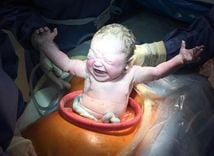This article is provided with professional advice by Dr. Nguyen Thi Man, Specialist grade I in Obstetrics and Gynecology at Vinmec Danang International General Hospital. Dr. Man has over 10 years of experience in diagnosing, advising, and treating in the field of Obstetrics and Gynecology.
Postpartum infection, also known as puerperal infection, is one of the most common obstetric complications. It occurs when bacteria enter through the genital tract via wounds during childbirth, then settle where the placenta attaches in the uterus, potentially affecting all parts of the genital tract or spreading further.
1. What is Postpartum Infection?
Postpartum infection occurs only in women after childbirth, caused by bacteria from the genital tract. In some cases, the infection may affect the perineum, vagina, vulva, cervix, or uterus. A small percentage of cases involve a bloodstream infection after delivery, which is severe and difficult to treat, carrying a high mortality rate.
Thanks to modern medicine, sterilization methods and aseptic techniques applied during childbirth have significantly reduced the incidence of puerperal infections. However, this condition remains quite common in rural, remote, and mountainous areas.
2. What Causes Postpartum Infection?
Medical research has established that common bacteria such as Staphylococcus, Streptococcus, anaerobic bacteria, and Escherichia coli (E. coli) can all act as causative agents of postpartum infections. These microorganisms are frequently present in our surrounding environment and can invade the body when favorable conditions arise. They typically enter through lesions in the vagina, vulva, or the placental attachment site at the uterine fundus, leading to infection.
Some primary causes of postpartum infection include:
- Infection of the vulva, perineum, vagina, or cervix due to improper sterilization during episiotomy or perineal suturing.
- Postpartum uterine infections, including endometritis, myometritis, and widespread uterine inflammation.
- Postpartum peritonitis, especially following cesarean delivery, uterine rupture, amniotic fluid infection, or unsanitary surgery.
- Bloodstream infection after delivery, which is the most severe form of postpartum infection and requires early detection and treatment.
The severity of postpartum infection depends on the bacterial toxicity, the health of the mother, and the antibiotic resistance of the pathogens. Early diagnosis and treatment are key factors in outcomes.

3. Signs of Postpartum Infection
In cases of postpartum infection, the clinical signs vary depending on the site of bacterial colonization, as follows:
- Perineal and vulvar infections are characterized by significant swelling, edema of the perineum and vulva, and purulent discharge from episiotomy stitches.
- Cervical and vaginal infections present with excessive foul-smelling discharge, and physical examination often causes pain.
- Uterine infections, though rare, tend to be more severe. Symptoms include foul-smelling lochia, potential bleeding, and sharp uterine pain upon palpation.
- Postpartum infections of the adnexa (ovaries, fallopian tubes, and ligaments) are typically prolonged and may progress to chronic conditions if not treated thoroughly.
Peritonitis, whether generalized or limited to the pelvic cavity, is a warning sign of bacterial spread from the reproductive system to the abdominal cavity or pelvis. This condition is highly dangerous, often necessitating surgical drainage. Improper management can result in postoperative complications.
- Pelvic vein thrombophlebitis manifests as swelling, pain, and warmth in the legs. If a blood clot dislodges and travels to the heart, it can lead to myocardial infarction; if it reaches the brain, it may cause a cerebral infarction, potentially resulting in sudden death. This form of infection carries a significant risk of fatality.
- Additionally, bacteria may directly enter the bloodstream from the reproductive organs, causing postpartum sepsis, which has an extremely high mortality rate.
4. What to Do If You Suspect a Postpartum Infection?

After delivery, the uterus undergoes a contraction process to expel lochia, which typically takes about two weeks. However, if after four days postpartum, the mother experiences a high fever, slow uterine involution, scant lochia, or a foul odor with tenderness upon uterine palpation, postpartum infection should be suspected. Immediate consultation with a healthcare provider is necessary for timely examination and treatment.
In cases where a postpartum woman has an infection in the perineum and vulva, treatment involves cleaning the vulva and perineum with antiseptic solutions, early removal of sutures if an episiotomy has been performed, and the use of local and systemic antibiotics. For infections of the cervix and vagina, sterile gauze should be used to clean the cervix and vagina daily, and antibiotics may be applied vaginally to eliminate the bacteria. If the infection is located in the uterus, a thorough examination should be performed to check for retained placental tissue or membranes.
To effectively prevent postpartum infections, every woman should maintain proper hygiene throughout pregnancy, especially in the days leading up to labor. It is crucial to avoid bathing or immersing oneself in contaminated bodies of water. If there is any suspicion of genital tract infection, immediate medical consultation and treatment should be sought.
Please dial HOTLINE for more information or register for an appointment HERE. Download MyVinmec app to make appointments faster and to manage your bookings easily.















